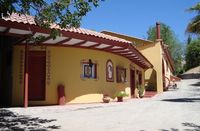Elqui valley & surroundings, Coquimbo region, Chile
Elqui valley & surroundings
| 2 day | 1 week | History |
|---|
 |  | | '
| Historical values: | | Min | Max |
|---|
| January | 10ºC / 50ºF | 23ºC / 73ºF |
| February | 10ºC / 50ºF | 23ºC / 73ºF |
| March | 7ºC / 45ºF | 21ºC / 70ºF |
| April | 5ºC / 41ºF | 18ºC / 64ºF |
| May | 3ºC / 37ºF | 16ºC / 61ºF |
| June | 1ºC / 34ºF | 14ºC / 57ºF |
| July | 1ºC / 34ºF | 14ºC / 57ºF |
| August | 2ºC / 36ºF | 14ºC / 57ºF |
| September | 3ºC / 37ºF | 16ºC / 61ºF |
| October | 5ºC / 41ºF | 18ºC / 64ºF |
| November | 7ºC / 45ºF | 21ºC / 70ºF |
| December | 9ºC / 48ºF | 22ºC / 72ºF |
Its one of the three valleys that run through the Region of Coquimbo, birthplace of the Chilean poet Gabriel Mistral, a place with astronomical observatories, producer of the best pisco (typical alcoholic beverage) to name a few of the attractions of the Elqui valley.
Pisco Elqui is situated at about 1.300 m above sea level, surrounded by vineyards and the magnificent mountain range of the Precordillera of the Andes. A, climate wise, paradise (300 sunny days a year) as well as kind and friendly inhabitants make this village an ideal place to recover from stress, tension and contamination.
To enter into it, is to experience, firsthand, the stark contrasts, blue skies, and various tones of the mountains; fresh, pure air, huge prairies with vineyards and papaya plantations. Additionally, it is also know for its natural magnetic vibrations, which has made this a place of interest for tourists who wish to practice yoga, relax or meditate; live naturally and take advantage of this almost perceptible energy.
Also, because of its incredibly clear skies, many travelers visit the observatories at Tololo and Mamalluca.
Another attractive feature is the warm climate, sun, fertile soil, sharp peaks and raging rivers.
The weather:
Pisco Elqui has a dry desert climate. In summer, temperatures average are between 26°C and 30°C. The winter is short, since the end of June until the end of August, and is well warm with an average temperature of 15°C.
According to the Holdridge life zones system of bioclimatic classification Pisco Elqui is situated in or near the boreal desert biome.
Total annual Precipitation averages 107.5 mm which equates to 107.5 Litres/m².
Pisco Elqui by the numbers: 

Pico Elqui by the numbers:
- Population (2022):
- Location:
- Lat, Long: (-30.0999996 -70.5333312)
- GPS Coordinates: -30°05'60.00" S, -70°31'59.99" W
- +/-
572 km (355.4 mi) north of Santiago
- Elevation:
- Timezone:
- CLT – Chile Standard Time (Current offset: UTC
-3 hrs)
Map: 
Astronomy: 
Astronomy
There are about a dozen observatories in northern Chile’s Elqui Valley region that cater to astrotourists (once known simply as stargazers). An oasis in an otherwise arid landscape, the roughly 90-mile-long valley stretches from the Pacific Ocean eastward into the Andean foothills. Its geography, with the cloud-blocking Andes to the east and the bone-dry Atacama Desert to the north, produces exceptionally clear conditions, optimal for stargazing.
Starting in the 1960s, a string of major international research telescopes were built here to take advantage of that, including Cerro Tololo, La Silla and Gemini South, and in 2014 work began on the planet’s most powerful space camera. Within five years, an estimated 70 percent of the world’s astronomical infrastructure will be in Chile, much of it in the Elqui Valley.
Pisco:
Pisco
Pisco is a colorless or yellowish-to-amber colored brandy produced in winemaking regions of Peru and Chile.
Made by distilling grape wine into a high-proof spirit, it was developed by 16th century Spanish settlers as an alternative to orujo, a pomace brandy that was being imported from Spain.
It had the advantages of being produced from abundant domestically grown fruit and reducing the volume of alcoholic beverages transported to remote locations.
Chilean pisco
A selection of Chilean piscos Chilean Pisco must be made in the country’s two official D.O. (Denomination of Origin) regions—Atacama and Coquimbo—established in 1931 by the government. Most of it is produced with a "boutique" type of distillate made by the Aguirre family among other producers. Others types are produced with double distillation in copper and other materials.
During the adaptation of many vineyards to pisco production, the most widespread grape was used as raw material, namely the Muscat, with some vineyards preferring the Torontel and Pedro Jiménez varieties. As is the case with Peru, regulations for pisco designations have been enacted in Chile, including the following classifications:
- Pisco Corriente o Tradicional, 30% to 35% (60 to 70 proof).
- Pisco Especial, 35% to 40% (70 to 80 proof).
- Pisco Reservado, 40% (80 proof).
- Gran Pisco, 43% or more (86 or more proof).
Regulation for pisco producing in Chile is quite high. Chilean distilleries are required to grow their own grapes and are grouped into two categories based in aromatic expressiveness: Muscat types (Pink Muscat, Muscat of Alexandria) are very fragrant, while Pedro Jiménez, Moscatel de Asturia and Torontel are more subtle.
The Special and Reserve variations are very similar in flavor and color, both being subtly sweet and of a clear birch to transparent color. The flavor is much stronger than regular pisco with aromatic refreshing tones.
The Great pisco has a commanding odor and a dark yellow color, it is not as sweet as the other varieties, yet it carries a strong woody flavor the others lack.[citation needed] The yellowish to amber color in Chilean pisco is due to the wood aging process, with the darker colors being a sign that they have been aged longer. Not all Chilean pisco is tinged, and the more mass-marketed brands can be clear.
Source
Description above is from the Wikipedia article
Pisco, licensed under
CC-BY-SA full list of contributors
here.






























 Webmasters:
Tasman Web Developers,
Webmasters:
Tasman Web Developers,  Hosting: Dreamhost
Hosting: Dreamhost